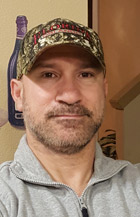Five Minutes With Audio & Video Home
fiveminuteswith
Seattle Environmental Lab Converts to LED Lighting
Ali Wandy, operating engineer for the King County Environmental Lab in Seattle, talks about his facility’s conversion to LED lighting, and the savings that the lab will experience.

Ali Wandy
Operating Engineer
King County Environmental Lab
Seattle, WA
1. Briefly describe the features of the environmental lab and how it serves King County.
The environmental laboratory helps protect the Puget Sound’s quality of life by providing field, laboratory, information, and advisory services to King County and other public agencies that protect and enhance water quality. The lab is a full-service facility, providing technical consultation, sample collection, analysis in five different lab areas, data management and interpretation. For example, if there is a fuel spill in Puget Sound or the water quality of a local lake is in jeopardy, the environmental lab provides the expertise to identify the extent of such problems and help natural resource managers make informed decisions about how to minimize harm to the environment, people, fish and wildlife.
2. When you were hired in 2011, you conducted an energy survey to determine savings opportunities. What did the results tell you about the state of the facility?
I did a walkthrough of all systems, to learn how they operate and to find any opportunities for improvements. During the initial survey, I found a good opportunity to save some energy by converting old 32 watt T12 fixtures, high-wattage halogen bulbs, and metal halite bulbs to a low-watt LED bulbs or new LED fixtures. I also found low-cost or no-cost repairs and adjustments to HVAC controls to get some extra savings on energy usage. Attending a Building Operator Certification (BOC) 1 Program training class helped me see the building more closely and examine it for more savings.
3. You chose to address the lighting system and install LEDs in 2012. Why did you decide to first address the lighting?
The lighting system is one of the systems that can be altered. Previous plans to make changes to lighting were unsuccessful due to the project’s high costs, because the big portion of the cost was the labor and they had not applied for incentives, which resulted in the rejection the project because the cost of material and labor did not justify the savings. My approach was to do the lighting survey, calculate current energy usage, estimate the proposed new lighting energy usage, factoring in in-house labor and incentives from the utility company, the new outcome of the project sounded more appealing to management and got it approved.
4. You successfully sought incentives from the local utility to help pay for the project. How essential are obtaining incentives for projects like these in getting a project off the ground, and what are some strategies you use to obtain them?
I contacted the local utility company to get information about whether my proposal will fit any incentives, and I was told to fill out forms and input all data collected from all lighting fixtures to a pre-programmed excel sheet that automatically calculates savings and incentives.
5. The facility saved thousands on labor by doing the conversions in-house. Describe the challenges involved with scheduling the work and installing the fixtures around the regular activities taking place in the facility.
It was very hard for me to do a lot of work in regular hours, and keeping up with the daily tasks. Another factor was not being able to shut down the power to the work areas. Some staff was against the changes, fearing that lighting may be different than before, and some staff did not take to the new color or intensity of the LEDs versus fluorescent tubes. In time everyone started to love the new lighting, especially hearing about the savings, and some were very pleased to know that we replaced all high mercury bulbs with zero mercury LED bulbs since the lab tests for mercury.schedule.
6. What kind of savings did the lab achieve due to the lighting projects?
The first stage was done in 2012, and the estimated yearly savings were 94,932 kilowatts (kWh), and 50 tons per year of greenhouse gas reductions, with a payback of 1.6 years and 63 percent return on investment (ROI), resulting in estimated $5,981 in annual cash savings. The second stage was done in 2015, and the estimated yearly savings were 82,000 KWh per year and 49 tons per year of greenhouse gas reduction, translating in estimated of $5,210 in annual cash savings, an 11 percent return on investment and 8.8 years payback.
7. What are the next steps for the lab in the efforts to save more energy?
We are currently evaluating the fume hood replacements in the building while at the same time trying to save energy. The new proposed fume hoods will have new controls capable of monitoring and programming more inputs, meaning more opportunity for fine-tuning the system and more savings. The new system can modulate the flow and speed of the fans based on demand, also can reduce the speed at night when they are not in use to save on energy. The plan also will involve replacing large numbers of fume hood exhaust fans on the roof to a lesser number on a manifold with fans to be controlled by VFDs.
Find more on this topic:
LED, lighting, HVAC
posted: 11/2/2015








